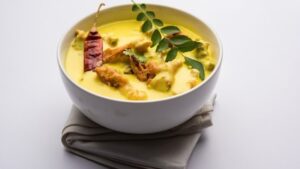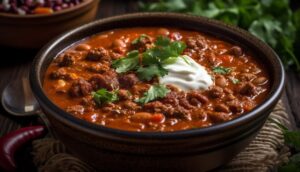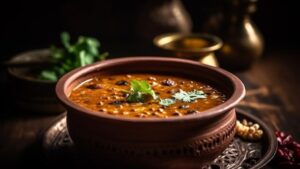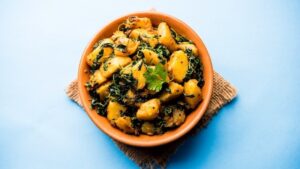Introduction:
In the vast tapestry of Indian cuisine, there are dishes that not only tantalize the taste buds but also evoke a sense of nostalgia and comfort. Among these culinary treasures stands kadhi pakora, a timeless classic beloved by many across the Indian subcontinent. In this blog, we embark on a flavorful journey through the origins, ingredients, preparation, and cultural significance of kadhi pakora, exploring why it holds a special place in the hearts and homes of millions.

The Origins of Kadhi Pakora
The origins of kadhi pakora are deeply rooted in the culinary traditions of the Indian subcontinent, particularly in the northwestern regions of India such as Punjab, Gujarat, and Rajasthan. While it is challenging to pinpoint an exact date or origin story for this beloved dish, its evolution can be traced back through centuries of cultural exchange and culinary innovation.
One theory suggests that kadhi pakora originated in the Punjab region, where it was initially prepared as a simple, nourishing meal for farmers and laborers. The combination of yogurt-based curry (kadhi) and gram flour fritters (pakoras) provided a hearty and satisfying dish that could be enjoyed during long days of work in the fields.
Another theory proposes that kadhi pakora has its roots in Gujarat, where it is known as “Kadhi.” In Gujarati cuisine, kadhi is typically thinner in consistency and slightly sweeter, often flavored with jaggery or sugar. The addition of fenugreek seeds, mustard seeds, and curry leaves in the tempering adds depth of flavor to the dish.
In Rajasthan, kadhi pakora takes on a spicier profile, with the inclusion of dried red chilies and whole spices like cloves and cinnamon in the tempering. This regional variation reflects the diverse culinary landscape of India, where each region adds its own unique twist to traditional recipes.
Over time, kadhi pakora has transcended regional boundaries and become a beloved dish enjoyed throughout India and beyond. Its versatility and adaptability have led to countless variations and interpretations, each reflecting the culinary preferences and cultural heritage of the communities that prepare it.
Today, kadhi pakora holds a special place in the hearts and homes of millions, cherished for its comforting flavors, nourishing qualities, and cultural significance. Whether enjoyed as a homely meal on a rainy day or as part of a festive feast, kadhi pakora continues to symbolize the timeless appeal of Indian cuisine and the rich tapestry of flavors that define it.
Health Benefits:
Kadhi pakora offers several health benefits, making it not only a delicious comfort food but also a nutritious choice:
Probiotic-rich
: The yogurt used in kadhi is a natural source of probiotics, which are beneficial bacteria that support gut health and digestion. Probiotics help maintain a healthy balance of gut flora, aiding in digestion and promoting overall gastrointestinal health.High in Protein
: Gram flour (besan), the main ingredient in pakoras, is rich in protein. Protein is essential for muscle repair and growth, as well as for the synthesis of enzymes and hormones in the body. Including protein-rich foods like kadhi pakora in your diet can help support muscle health and keep you feeling full and satisfied.Rich in Fiber
: Gram flour is also a good source of dietary fiber, which is important for digestive health and regular bowel movements. Fiber helps promote satiety, regulate blood sugar levels, and lower cholesterol levels, reducing the risk of heart disease and improving overall cardiovascular health.Vitamins and Minerals
: Kadhi pakora contains various vitamins and minerals, including B vitamins, iron, magnesium, and zinc, which are essential for energy production, immune function, and overall well-being. These nutrients play crucial roles in various physiological processes in the body, supporting optimal health and vitality.Low in Calories
: When prepared with minimal oil and served with whole grains like rice or roti, kadhi pakora can be a relatively low-calorie meal option. Choosing lighter cooking methods and incorporating nutrient-dense ingredients can help reduce the overall calorie content of the dish while still providing essential nutrients and flavor.Antioxidant Properties
: Some of the spices used in kadhi pakora, such as turmeric and fenugreek seeds, possess antioxidant properties. Antioxidants help neutralize harmful free radicals in the body, reducing oxidative stress and inflammation, and lowering the risk of chronic diseases such as cancer, diabetes, and heart disease.
Overall, kadhi pakora can be a nutritious and satisfying addition to a balanced diet when prepared with wholesome ingredients and mindful cooking techniques. Enjoying this flavorful dish in moderation can contribute to overall health and well-being, while also treating your taste buds to a delicious culinary experience.
Regional Variations:
Kadhi pakora, a beloved dish in Indian cuisine, exhibits fascinating regional variations across different parts of the country. Here are some notable regional variations:
Punjabi Kadhi Pakora
: Hailing from the vibrant state of Punjab, Punjabi kadhi pakora is known for its rich and creamy texture. The kadhi is typically thickened with besan (gram flour) and yogurt, resulting in a luscious gravy. The pakoras, often made with onions, potatoes, or spinach, are fried until golden brown and crispy. Punjabi kadhi pakora is generously seasoned with a blend of spices like cumin, coriander, and garam masala, imparting a bold and flavorful profile.Gujarati Kadhi
: In Gujarat, kadhi takes on a slightly different character. Gujarati kadhi is thinner in consistency compared to its Punjabi counterpart, with a tangy and slightly sweet flavor profile. It is often flavored with jaggery or sugar, balancing the tartness of the yogurt. The tempering (tadka) typically includes mustard seeds, fenugreek seeds, and curry leaves, adding depth and aroma to the dish. Gujarati kadhi is traditionally served with khichdi (a rice and lentil dish) or steamed rice.Rajasthani Kadhi
: Rajasthani kadhi is renowned for its spicy kick and robust flavors. This variation features a thinner consistency kadhi, similar to Gujarati kadhi, but with the addition of dried red chilies and whole spices such as cloves, cinnamon, and bay leaves. The tempering is often prepared with ghee (clarified butter) for richness and flavor. Rajasthani kadhi is typically served with bajra roti (millet flatbread) or rice, offering a hearty and satisfying meal.Maharashtrian Kadhi
: Maharashtrian kadhi showcases its own unique flair with the addition of kokum (a souring agent) or tamarind, which lends a tangy twist to the dish. The kadhi is tempered with mustard seeds, cumin seeds, and curry leaves, enhancing its aroma and flavor. Maharashtrian kadhi is often served with steamed rice or bhakri (a type of unleavened bread), providing a comforting and wholesome meal.
These regional variations of kadhi pakora highlight the diverse culinary landscape of India, each offering a distinct interpretation of this beloved dish. Whether you prefer the creamy richness of Punjabi kadhi, the tangy sweetness of Gujarati kadhi, the spicy kick of Rajasthani kadhi, or the zesty flavor of Maharashtrian kadhi, there’s a kadhi pakora variation to suit every palate and preference.
Ingredients That Define Kadhi Pakora:
Kadhi pakora, a quintessential dish in Indian cuisine, is defined by its unique blend of ingredients that contribute to its distinct flavor and texture. Let’s explore the key components that define kadhi pakora:
For the Kadhi (Yogurt-based Curry):
Yogurt (Dahi):
The base of the kadhi, yogurt provides a creamy and tangy flavor to the curry. It’s essential to use plain yogurt without any added flavorings or sweeteners.Besan (Gram Flour):
Also known as chickpea flour, besan acts as a thickening agent for the kadhi, giving it a smooth and velvety consistency. It also adds a nutty flavor to the dish.Spices:
A blend of aromatic spices is used to season the kadhi, typically including turmeric (haldi), cumin (jeera), coriander (dhania), fenugreek seeds (methi), and sometimes asafoetida (hing).Ginger and Garlic:
Fresh ginger and garlic are minced or grated and added to the kadhi for their pungent and aromatic flavors.Green Chilies:
Sliced or chopped green chilies add a subtle heat to the kadhi, balancing the richness of the yogurt and besan.Curry Leaves:
Fresh curry leaves are often used to temper the kadhi, infusing it with a distinctive fragrance and flavor.
For the Pakoras (Gram Flour Fritters):
Gram Flour (Besan):
The main ingredient for making pakoras, gram flour forms the base of the batter. It’s a gluten-free flour made from ground chickpeas.Onions:
Finely chopped onions are commonly added to the pakora batter, providing sweetness and texture.Green Chilies:
Diced green chilies contribute a spicy kick to the pakoras, enhancing their flavor.Fresh Herbs:
Chopped fresh cilantro (coriander) leaves or other herbs like mint or parsley add freshness and aroma to the pakoras.Baking Soda:
A small amount of baking soda is often added to the pakora batter to make the fritters light and airy.Salt and Spices:
Salt and spices such as turmeric, cumin, and chili powder are added to the pakora batter for seasoning.
These ingredients come together harmoniously to create the irresistible combination of creamy kadhi and crispy pakoras that defines kadhi pakora. Whether enjoyed as a comforting meal on a rainy day or as a festive dish during celebrations, kadhi pakora is a culinary delight that showcases the rich flavors and textures of Indian cuisine.
Cultural Significance and Enjoyment:
Beyond its culinary appeal, kadhi pakora holds cultural significance as a staple comfort food enjoyed during festivals, family gatherings, and everyday meals. Its comforting flavors and nourishing qualities make it a cherished dish that brings people together, evoking memories of home-cooked meals and shared moments of joy.




